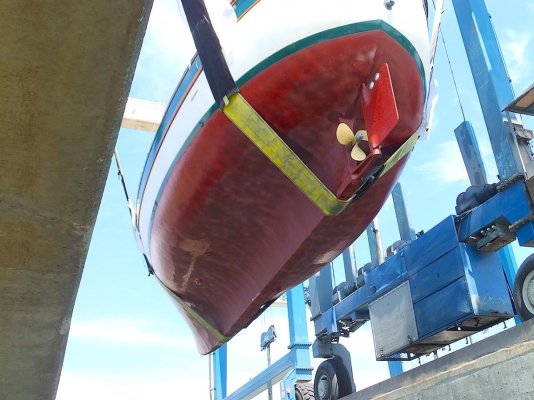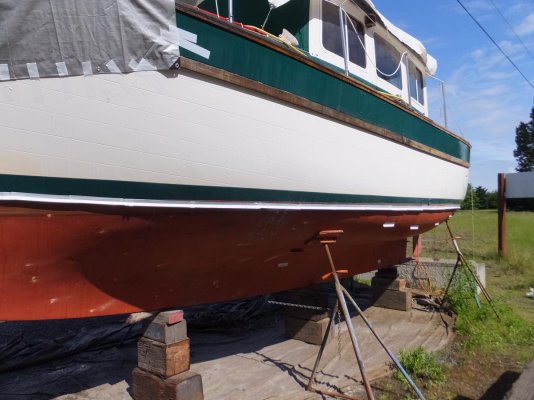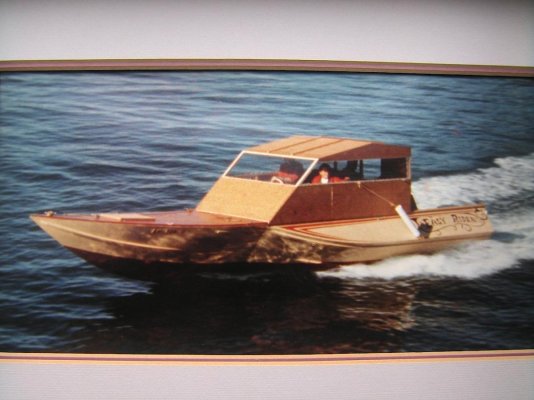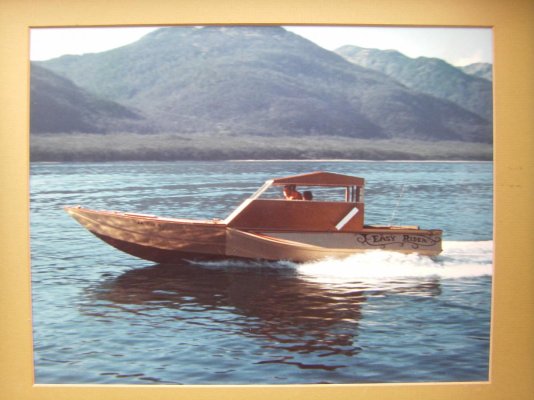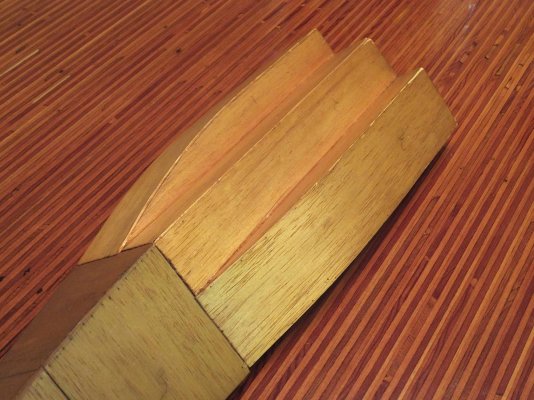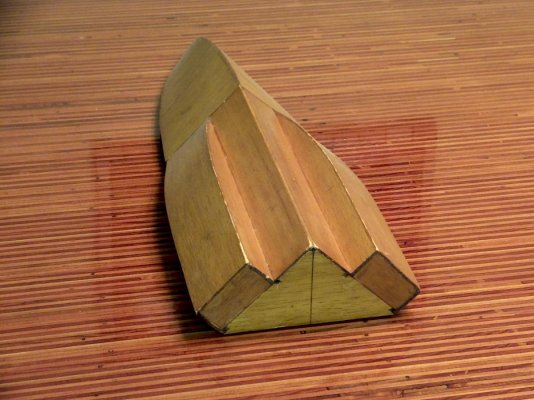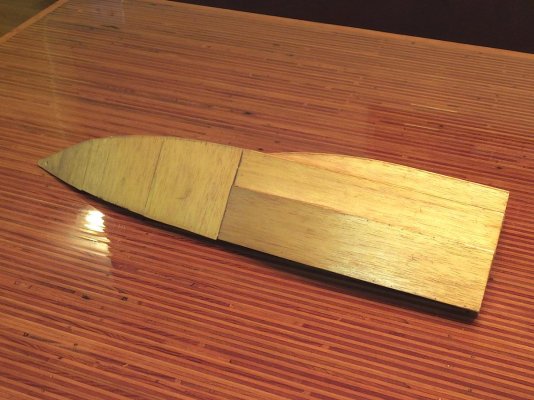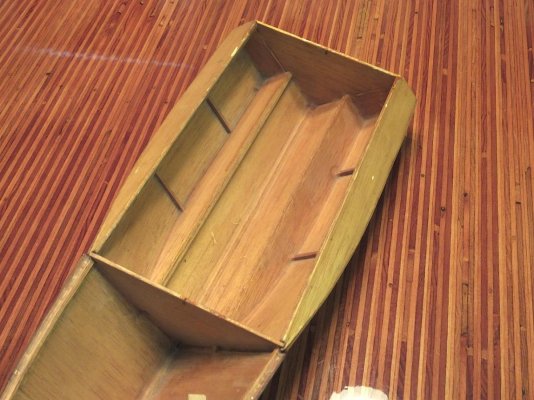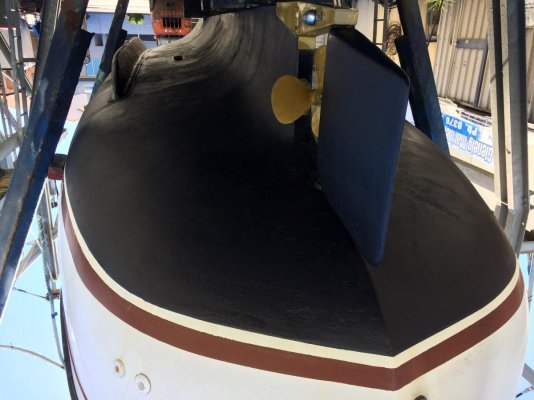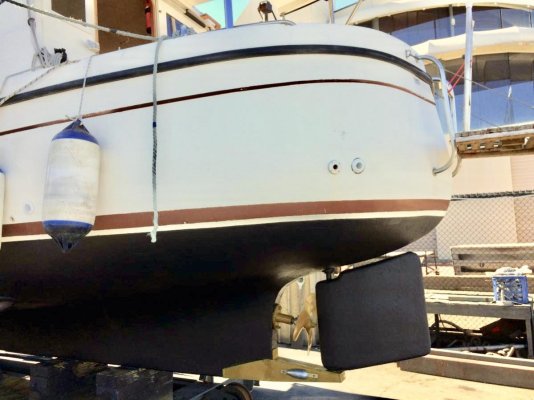You are using an out of date browser. It may not display this or other websites correctly.
You should upgrade or use an alternative browser.
You should upgrade or use an alternative browser.
Canoe (or double end) boats efficient?
- Thread starter Nomad Willy
- Start date
The friendliest place on the web for anyone who enjoys boating.
If you have answers, please help by responding to the unanswered posts.
If you have answers, please help by responding to the unanswered posts.
Hippocampus
Guru
- Joined
- Jul 27, 2020
- Messages
- 4,182
- Location
- Plymouth
- Vessel Name
- Hippocampus
- Vessel Make
- Nordic Tug 42
Very pretty. Nice slack bilges and not much draft to the keel. But it’s a good example of a fairly balanced hull form. Would think a well behaved vessel.
fryedaze
Guru
- Joined
- Sep 4, 2011
- Messages
- 1,753
- Location
- USA
- Vessel Name
- Fryedaze
- Vessel Make
- MC 42 (Overseas Co) Monk 42
German short hair on a boat. My son has one that He trained to hunt birds. He is seven and still has way to much energy to be on a boat. I hear they are pups for life.Our KK54 is setup with a swing down door/platform used for boarding from a floating dock or the dingy.
The dogs got used to it pretty quickly and now jump on or off easily. So far they’ve only gone in the drink once!
View attachment 108309
Last edited:
Nomad Willy
Guru
Very pretty. Nice slack bilges and not much draft to the keel. But it’s a good example of a fairly balanced hull form. Would think a well behaved vessel.
I included another picture above in post # 31 to show the real hull depth.
And yes she performs very well.
silverback
Veteran Member
There are, as i understand it, a couple of reasons for the double ender. One is that they were a lot stronger construction in the ( timber ) years of yore. The other is that a canoe shape underwater means that directional stability is better as she rolls.
I have sailed many miles in the two that i owned. In 1990 on my way across the Tasman to New Zealand to compete in the solo Trans Tasman race i was caught in the tail of cyclone Hilda. The Tasman for those fortunate enough not to have sailed is a singularly unpleasant bit of ocean.I was in a timber, splined Carmen. 31’ with very fine ends. As winds climbed over 60 knots i resorted to running with a great bunch of lines astern. Worked very well. A couple of knockdowns resulted in some broken ribs. Mine not the boats! In short the canoe stern behaved well as she had a fair bit of overhang giving reserve buoyancy. Im sure the canoe shape saved me from worse broaches.Barn door of rudder on stern post and Airies wind vane got be through it. Not sure how this applies to full displacement modern motor boats. Im sure i can remember a naval architect explained that if the hull shape can be kept The same as she heels there are influences causing crankiness. Do like my lazarette i must say.
I have sailed many miles in the two that i owned. In 1990 on my way across the Tasman to New Zealand to compete in the solo Trans Tasman race i was caught in the tail of cyclone Hilda. The Tasman for those fortunate enough not to have sailed is a singularly unpleasant bit of ocean.I was in a timber, splined Carmen. 31’ with very fine ends. As winds climbed over 60 knots i resorted to running with a great bunch of lines astern. Worked very well. A couple of knockdowns resulted in some broken ribs. Mine not the boats! In short the canoe stern behaved well as she had a fair bit of overhang giving reserve buoyancy. Im sure the canoe shape saved me from worse broaches.Barn door of rudder on stern post and Airies wind vane got be through it. Not sure how this applies to full displacement modern motor boats. Im sure i can remember a naval architect explained that if the hull shape can be kept The same as she heels there are influences causing crankiness. Do like my lazarette i must say.
markpierce
Master and Commander
- Joined
- Sep 25, 2010
- Messages
- 12,557
- Location
- USA
- Vessel Name
- Carquinez Coot
- Vessel Make
- penultimate Seahorse Marine Coot hull #6
Remembering broaching several times nearly under Golden Gate Bridge overal several years while flying spinnaker. Easily recovered (let loose the clew sheet). Not unusual to reach 12 knots sliding down the waves on Dad's 28.5-foot heavy displacement sailboat.
Last edited:
silverback
Veteran Member
Ah the blessings of a full keel!
Hippocampus
Guru
- Joined
- Jul 27, 2020
- Messages
- 4,182
- Location
- Plymouth
- Vessel Name
- Hippocampus
- Vessel Make
- Nordic Tug 42
There’s been several 100+ post long threads on several sail sites discussing the seaworthiness of old school full keel heavy displacement boats. A segment continues to adhere to being their proponents. This in spite of
All evidence from recorded experience shows them to be less safe
All evidence from computer modeling shows them to be less safe.
Current understanding of wave and boat hydrodynamics shows them to be less safe.
In response to the above NO full keel heavy displacement boats are in current production. The last (Island Packet) folded several years ago as the public refused to buy a boat with poor sailing performance that offered no safety advantage. Please note this is not due to expense. A properly constructed balanced spade rudder/ bulbed fin keeled boat is more expensive to produce as is a lift keel or centerboard.
Naval architects are ingenious and now have multiple tools at their disposal they didn’t previously have. They have made full use of them. As a child and young adult I fell in love with the romance of Fife, Hand, Atkins Perry boats. But even the wizard of Bristol knew better long before I was borne. Yes he did a few double ended and was limited to full keels in many designs because of the limitations of WOOD construction. But that was a century ago. The world has moved on and so should we.
All evidence from recorded experience shows them to be less safe
All evidence from computer modeling shows them to be less safe.
Current understanding of wave and boat hydrodynamics shows them to be less safe.
In response to the above NO full keel heavy displacement boats are in current production. The last (Island Packet) folded several years ago as the public refused to buy a boat with poor sailing performance that offered no safety advantage. Please note this is not due to expense. A properly constructed balanced spade rudder/ bulbed fin keeled boat is more expensive to produce as is a lift keel or centerboard.
Naval architects are ingenious and now have multiple tools at their disposal they didn’t previously have. They have made full use of them. As a child and young adult I fell in love with the romance of Fife, Hand, Atkins Perry boats. But even the wizard of Bristol knew better long before I was borne. Yes he did a few double ended and was limited to full keels in many designs because of the limitations of WOOD construction. But that was a century ago. The world has moved on and so should we.
Hippocampus
Guru
- Joined
- Jul 27, 2020
- Messages
- 4,182
- Location
- Plymouth
- Vessel Name
- Hippocampus
- Vessel Make
- Nordic Tug 42
There’s been several 100+ post long threads on several sail sites discussing the seaworthiness of old school full keel heavy displacement boats. A segment continues to adhere to being their proponents. This in spite of
All evidence from recorded experience shows them to be less safe
All evidence from computer modeling shows them to be less safe.
Current understanding of wave and boat hydrodynamics shows them to be less safe.
In response to the above NO full keel heavy displacement boats are in current production. The last (Island Packet) folded several years ago as the public refused to buy a boat with poor sailing performance that offered no safety advantage. Please note this is not due to expense. A properly constructed balanced spade rudder/ bulbed fin keeled boat is more expensive to produce as is a lift keel or centerboard.
Naval architects are ingenious and now have multiple tools at their disposal they didn’t previously have. They have made full use of them. As a child and young adult I fell in love with the romance of Fife, Hand, Atkins and Perry boats. But even the wizard of Bristol knew better long before I was borne. Yes he did a few double ended and was limited to full keels in many designs because of the limitations of WOOD construction. But that was a century ago. The world has moved on and so should we.
All evidence from recorded experience shows them to be less safe
All evidence from computer modeling shows them to be less safe.
Current understanding of wave and boat hydrodynamics shows them to be less safe.
In response to the above NO full keel heavy displacement boats are in current production. The last (Island Packet) folded several years ago as the public refused to buy a boat with poor sailing performance that offered no safety advantage. Please note this is not due to expense. A properly constructed balanced spade rudder/ bulbed fin keeled boat is more expensive to produce as is a lift keel or centerboard.
Naval architects are ingenious and now have multiple tools at their disposal they didn’t previously have. They have made full use of them. As a child and young adult I fell in love with the romance of Fife, Hand, Atkins and Perry boats. But even the wizard of Bristol knew better long before I was borne. Yes he did a few double ended and was limited to full keels in many designs because of the limitations of WOOD construction. But that was a century ago. The world has moved on and so should we.
mvweebles
Guru
- Joined
- Mar 21, 2019
- Messages
- 7,778
- Location
- United States
- Vessel Name
- Weebles
- Vessel Make
- 1970 Willard 36 Trawler
Why is a full keel boat less safe? And does the principle follow to powerboats? One of the big reasons I decided to bring my Willard to Florida was the grounding protection. Sailboats have inherent prop protection that powerboats do not. Point being there are some inherent differences when balancing a big stick with acres of fabric vs a powerboat.There’s been several 100+ post long threads on several sail sites discussing the seaworthiness of old school full keel heavy displacement boats. A segment continues to adhere to being their proponents. This in spite of
All evidence from recorded experience shows them to be less safe
All evidence from computer modeling shows them to be less safe.
Current understanding of wave and boat hydrodynamics shows them to be less safe.
In response to the above NO full keel heavy displacement boats are in current production. The last (Island Packet) folded several years ago as the public refused to buy a boat with poor sailing performance that offered no safety advantage. Please note this is not due to expense. A properly constructed balanced spade rudder/ bulbed fin keeled boat is more expensive to produce as is a lift keel or centerboard.
Naval architects are ingenious and now have multiple tools at their disposal they didn’t previously have. They have made full use of them. As a child and young adult I fell in love with the romance of Fife, Hand, Atkins and Perry boats. But even the wizard of Bristol knew better long before I was borne. Yes he did a few double ended and was limited to full keels in many designs because of the limitations of WOOD construction. But that was a century ago. The world has moved on and so should we.
Good thread.
Hippocampus
Guru
- Joined
- Jul 27, 2020
- Messages
- 4,182
- Location
- Plymouth
- Vessel Name
- Hippocampus
- Vessel Make
- Nordic Tug 42
Totally true. Sailboats can alter their physics and even geometriy but power can’t. Center of effort is variable on sail as is depth. Righting arm is easily achieved with a bulbed keel. With tankage below the waterline, smaller and baffled the physics are different when perturbed. Last sail boat had 4 fuel tanks and 2 water tanks. All within a few feet of metacenter. AVS of 130 is easily achieved and area under null in the Gz curve easy to keep very small. Much easier to achieve a good seaboat. Even 26’ sali boats go RTW without difficulties and survive knockdowns but keep on keeping on.
More difficult for the NA looking at designing a seagoing recreational powerboat. Trivial down flooding which wouldn’t impaired the function of sail can disable power if engine intakes are compromised.
As explained above full keels have less draft than fin. The Pb or cast Fe more dispersed. To achieve the same righting arm either more weight need be used or a dramatic increase in wetted surface by increasing draft. In either case the lateral profile increases. Boat losses ability to slide down a wave unless nearly perpendicular. Boat is more likely to be overcome when in any position other than perpendicular. Much more difficult to achieve AVS >120 which is considered the minimum for blue water. Rudder control is much less unless quite large. Rudder is usually unbalanced so steering more difficult and response time longer. The list goes on.
Yes in my eyes most FD trawlers are full keel. However the keel doesn’t have the requirements engendered by having a sailplan. Almost universally they are deeper aft. l Power boats are usually much more dependent on form stability. Sail typical has 35-50% Ballast/displacement whereas 8-12% is common on blue water power. At every aspect a totally different design problem, different required behavior in weather by crew, just different. A lot of what I learned about sail just doesn’t apply for power. I have so much to learn. What’s disappointing so far is how difficult it is to get reliable information and insight. Unlike with sail where just about every boat has a Gz curve and AVS published on the Internet that’s not true for power. Average days work, and sailing polars are easily available. Similar statistics for power are struggle to get. Boats nm per gallon, days work, and annual cost of ownership are hard to find. Dealers and manufacturers website site give you pretty pictures but few hard facts. I’ve resorted to the boat builders websites and I’m learning. But I’m not going to buy another one off and want to know more about production boats and FD power in general.
Would greatly appreciate advice where to look. Have read the 4th edition of Beebe cover to cover. Have read Kasten, Gerr, Bueller etc. Where else can I get that basic knowledge? Norhavn dreamers is useless for that stuff. The KK site is too focused. Are there any good websites (other than here) and/or books appropriate for a newbie like me?
More difficult for the NA looking at designing a seagoing recreational powerboat. Trivial down flooding which wouldn’t impaired the function of sail can disable power if engine intakes are compromised.
As explained above full keels have less draft than fin. The Pb or cast Fe more dispersed. To achieve the same righting arm either more weight need be used or a dramatic increase in wetted surface by increasing draft. In either case the lateral profile increases. Boat losses ability to slide down a wave unless nearly perpendicular. Boat is more likely to be overcome when in any position other than perpendicular. Much more difficult to achieve AVS >120 which is considered the minimum for blue water. Rudder control is much less unless quite large. Rudder is usually unbalanced so steering more difficult and response time longer. The list goes on.
Yes in my eyes most FD trawlers are full keel. However the keel doesn’t have the requirements engendered by having a sailplan. Almost universally they are deeper aft. l Power boats are usually much more dependent on form stability. Sail typical has 35-50% Ballast/displacement whereas 8-12% is common on blue water power. At every aspect a totally different design problem, different required behavior in weather by crew, just different. A lot of what I learned about sail just doesn’t apply for power. I have so much to learn. What’s disappointing so far is how difficult it is to get reliable information and insight. Unlike with sail where just about every boat has a Gz curve and AVS published on the Internet that’s not true for power. Average days work, and sailing polars are easily available. Similar statistics for power are struggle to get. Boats nm per gallon, days work, and annual cost of ownership are hard to find. Dealers and manufacturers website site give you pretty pictures but few hard facts. I’ve resorted to the boat builders websites and I’m learning. But I’m not going to buy another one off and want to know more about production boats and FD power in general.
Would greatly appreciate advice where to look. Have read the 4th edition of Beebe cover to cover. Have read Kasten, Gerr, Bueller etc. Where else can I get that basic knowledge? Norhavn dreamers is useless for that stuff. The KK site is too focused. Are there any good websites (other than here) and/or books appropriate for a newbie like me?
Last edited:
Nomad Willy
Guru
Perhaps the answer to this question is related to the (fin keel/full keel) difference.
You are very very much into sailboats to the extent that none of us have ever heard of what you speak of. And of course sailboats have sails .. and tall masts. All of this must be involved in what makes the most seaworthy boat. For example w sails up the pressure on the jib and mizzen or aft end of a main will offer a great deal of directional stability. Trawlers lack that. Also sailboats having sails aloft receive a great deal of roll stability .. that trawlers also lack. Sure they heel way over but they are stably fixed as heeled and don’t roll back and forth. Furthermore they aren’t subject to the inertia of the dynamically rolling and yawing boat.
So w very different dynamics a different outcome is likely. It’s a bit hard to imagine a boat w all that gear extending way up high w all the weight of ballast and odd shapes that seem unnecessary to powerboaters would actually make them (sailboats) more instead of less seaworthy.
So I propose that it is not the full keel that makes trawlers less seaworthy (if indeed they are) but the lack of a full keel .. specifically it’s ends. It should be obvious that having keels that extend way fwd and aft of typical CG would/should promote movements and dynamics that do not aid seaworthyness. As an example my Willard’s full keel that extends well aft and has a big barn door rudder that in benign conditions provides much directional stability. But when the waves get big the rudder hangs way out there where laterally moving water can put very significant lateral forces on same. So in fast moving seas w a boat’s stern perched up there, her stern quarter trying to occupy the same space not only is subject to the sea crest rushing fwd but that the rudder being far from the CG means there is great yawing forces present. And an airplane w a big rudder and more importantly a big vertical stabilizer can get turned almost 90 degrees quickly. But on a boat water has more authority and moving water controlling the boat probably is not a good thing.
A fin keeled sailboat w sails aloft has great directional stability from her sails whereas a trawler must get most of her directional stability from the full keel. The helmsman can shout “don’t do that” to the sea but waves rush fwd on the crest and any boat w it’s end on/in the rushing crest must accept that some dynamic things may happen that will possibly broach the boat. Very importantly the sailboat has her ends open so the rushing crests have little effect on directional stability as they can rush past under the hull ends w/o upsetting directional stability w the directional assistance of the sails conveniently in a nearby fluid. Air.
So the sailboat gets much or most of it’s directional stability from sails and dosn’t get pushed around because it’s keel is short thus lacking the cheater bar-like force the extended full keel has.
I may have missed something, something very important but I think the above may explain hippocampus’s claims.
You are very very much into sailboats to the extent that none of us have ever heard of what you speak of. And of course sailboats have sails .. and tall masts. All of this must be involved in what makes the most seaworthy boat. For example w sails up the pressure on the jib and mizzen or aft end of a main will offer a great deal of directional stability. Trawlers lack that. Also sailboats having sails aloft receive a great deal of roll stability .. that trawlers also lack. Sure they heel way over but they are stably fixed as heeled and don’t roll back and forth. Furthermore they aren’t subject to the inertia of the dynamically rolling and yawing boat.
So w very different dynamics a different outcome is likely. It’s a bit hard to imagine a boat w all that gear extending way up high w all the weight of ballast and odd shapes that seem unnecessary to powerboaters would actually make them (sailboats) more instead of less seaworthy.
So I propose that it is not the full keel that makes trawlers less seaworthy (if indeed they are) but the lack of a full keel .. specifically it’s ends. It should be obvious that having keels that extend way fwd and aft of typical CG would/should promote movements and dynamics that do not aid seaworthyness. As an example my Willard’s full keel that extends well aft and has a big barn door rudder that in benign conditions provides much directional stability. But when the waves get big the rudder hangs way out there where laterally moving water can put very significant lateral forces on same. So in fast moving seas w a boat’s stern perched up there, her stern quarter trying to occupy the same space not only is subject to the sea crest rushing fwd but that the rudder being far from the CG means there is great yawing forces present. And an airplane w a big rudder and more importantly a big vertical stabilizer can get turned almost 90 degrees quickly. But on a boat water has more authority and moving water controlling the boat probably is not a good thing.
A fin keeled sailboat w sails aloft has great directional stability from her sails whereas a trawler must get most of her directional stability from the full keel. The helmsman can shout “don’t do that” to the sea but waves rush fwd on the crest and any boat w it’s end on/in the rushing crest must accept that some dynamic things may happen that will possibly broach the boat. Very importantly the sailboat has her ends open so the rushing crests have little effect on directional stability as they can rush past under the hull ends w/o upsetting directional stability w the directional assistance of the sails conveniently in a nearby fluid. Air.
So the sailboat gets much or most of it’s directional stability from sails and dosn’t get pushed around because it’s keel is short thus lacking the cheater bar-like force the extended full keel has.
I may have missed something, something very important but I think the above may explain hippocampus’s claims.
Last edited:
Hippocampus
Guru
- Joined
- Jul 27, 2020
- Messages
- 4,182
- Location
- Plymouth
- Vessel Name
- Hippocampus
- Vessel Make
- Nordic Tug 42
Some good insights Eric but feel I don’t know enough about the complexities to respond. It’s here we need input from a NA or even an amateur dilettante more knowledgeable than me. Been frustrated in the past when someone focuses on one feature in a boat not accepting the whole boat works as a unit. I know ever since Beebe recreational power has done innumerable passages and these vessels have seen what the ocean offers. I know commercial fishermen have a very dangerous job but most injuries are from machinery not weather. Those small boats are remarkably seaworthy. I know crew and vessel are equally important to a successful voyage. Want to publicly thank you for your contributions.
Are there other passage making skippers out there who would be kind enough to share their experience and knowledge?
Are there other passage making skippers out there who would be kind enough to share their experience and knowledge?
Hippocampus
Guru
- Joined
- Jul 27, 2020
- Messages
- 4,182
- Location
- Plymouth
- Vessel Name
- Hippocampus
- Vessel Make
- Nordic Tug 42
Would just add a deep V hull can have good directional stability without a keel. A long, narrow hull as well. There’s a reason they do those tank tests with colored streams and those computer analyses. Any way you get attached laminar flow would seem to increase that feature .
mvweebles
Guru
- Joined
- Mar 21, 2019
- Messages
- 7,778
- Location
- United States
- Vessel Name
- Weebles
- Vessel Make
- 1970 Willard 36 Trawler
Slocum circumnavigate in an old hay barge. Good thing he didn't know better. Though I am reminded he was later lost at sea.
For the most part, forums like these have a lot of people who are long on theory and short on experience. Perception is you have to be prepared for any weather. I understand the statement but I mostly disagree. That implies it's possible to be surprised by a hurricane. At 7-kts, you can travel 500 miles in 3 days, the window of reasonably reliable wx forecast (though you do need skill to interpret). Keep a rolling 500 mile itinerary with bail outs and you can go great distances. Can't cross an ocean so you need to plan for season. You may get surprised by 8-foot @ 6-seconds when you were expecting 5-foot @ 8-seconds, but that's not life threatening. It's damn uncomfortable and scary if you've never been in it, but not a safety issue for most boats.
For me, I want a comfortable seaboat. High bow, low A/B, and plenty of ballast (25% on my Willard) gets me there for anything I might encounter - I may make 7-8 day runs, but will always have a 3 day bail-out for changes in weather. That gives me a rolling 500 nm range. There's a lot of cruising in that span.
Just depends on you plan to use the boat.
Peter
For the most part, forums like these have a lot of people who are long on theory and short on experience. Perception is you have to be prepared for any weather. I understand the statement but I mostly disagree. That implies it's possible to be surprised by a hurricane. At 7-kts, you can travel 500 miles in 3 days, the window of reasonably reliable wx forecast (though you do need skill to interpret). Keep a rolling 500 mile itinerary with bail outs and you can go great distances. Can't cross an ocean so you need to plan for season. You may get surprised by 8-foot @ 6-seconds when you were expecting 5-foot @ 8-seconds, but that's not life threatening. It's damn uncomfortable and scary if you've never been in it, but not a safety issue for most boats.
For me, I want a comfortable seaboat. High bow, low A/B, and plenty of ballast (25% on my Willard) gets me there for anything I might encounter - I may make 7-8 day runs, but will always have a 3 day bail-out for changes in weather. That gives me a rolling 500 nm range. There's a lot of cruising in that span.
Just depends on you plan to use the boat.
Peter
Nomad Willy
Guru
My Easy Rider from the 70's
Hipp,
Thanks for your flattering response.
They usta say that Ddeep V boats had poor directional stability and I always questioned that.
In the late 60's I was in college studying Industrial Education. During that time I designed a deep V hull that worked well. I did. But of course as in all things there are compromises that arise. And you could argue she's not a deep V at all but a cathedral hull. Maybe even a trimaran.
I made a bulsa model but testing by towing it revealed little. The model in the pics is the same one.
By the time I got to Maset in the Queen Charolette Islands I still hadn't done any meaningful testing. So having the school shop handy and w permission I made it a class project ... building my prototype.
We did it and the students really got into it and were proud taking rides in the finished boat.
The description of the hull was a very deep V (45 degrees) with sponsons outboard to provide stability.
The boat built was 9X28'. Seven foot beam at the gunnels. 90% of the sheathing was 3/8ths Canadian Marine plywood. Parts of the stern and center bottom was 3/4" and 3/8ths". I never did weigh the hull and wish I had. But she performed extremely well w two faults. I named her Easy Rider (before the movie) and seaworthiness wise she had very little stability fwd. Uniflite is a good example of a boat w wide chines fwd and good input from the bow re stability. But the fwd end of the ER has so little stability fwd there were some white knuckle times on 10' seas (or so). Fortunately the very high stability aft kept me from real danger.
The other thing that kept her from being a design attractive to the commercial market was her poor load carrying ability. I knew that ahead of building her so keeping her extra light was a goal. 3/16" plexiglass windows, plastic cleats, 1/4" plywood cabin, single frame construction and more kept the ER light.
Power was a 3 cyl. Johnson OB. Oil injection two stroke. Had a max fuel capacity of about 55gal. When doing a long run I'd put on my 11" pitch prop and after burning off 20 or so gallons I'd switch back to the usual 13" pitch. Top speed was close to 20 and cruise was about 13 knots. Consumption was about 2.5 gph.
When we (1st wife) and I came south we ran the boat down. Had a great trip. The ER exists no more ... sadly.
But to your post #44 Hipp the ER had the most fantastic directional stability I've ever experienced. Almost flat and tight turns and as soft a ride as could be expected. Could take 10' seas head on but couldn't make much progress. On the trip so we encountered such seas approaching tree point in Dixon Entrance. Had to pick our way between the rocks w white water thereon but made it into Very Inlet and a smug anchorage. We were there for 5 days watching the Ak ferries taking water over the foredeck and much spray on the bridge.
But on the trip the ER proved herself well on almost all counts. And yes Hipp a deep keel is not necessary w a deep enough hull.
Hipp,
Thanks for your flattering response.
They usta say that Ddeep V boats had poor directional stability and I always questioned that.
In the late 60's I was in college studying Industrial Education. During that time I designed a deep V hull that worked well. I did. But of course as in all things there are compromises that arise. And you could argue she's not a deep V at all but a cathedral hull. Maybe even a trimaran.
I made a bulsa model but testing by towing it revealed little. The model in the pics is the same one.
By the time I got to Maset in the Queen Charolette Islands I still hadn't done any meaningful testing. So having the school shop handy and w permission I made it a class project ... building my prototype.
We did it and the students really got into it and were proud taking rides in the finished boat.
The description of the hull was a very deep V (45 degrees) with sponsons outboard to provide stability.
The boat built was 9X28'. Seven foot beam at the gunnels. 90% of the sheathing was 3/8ths Canadian Marine plywood. Parts of the stern and center bottom was 3/4" and 3/8ths". I never did weigh the hull and wish I had. But she performed extremely well w two faults. I named her Easy Rider (before the movie) and seaworthiness wise she had very little stability fwd. Uniflite is a good example of a boat w wide chines fwd and good input from the bow re stability. But the fwd end of the ER has so little stability fwd there were some white knuckle times on 10' seas (or so). Fortunately the very high stability aft kept me from real danger.
The other thing that kept her from being a design attractive to the commercial market was her poor load carrying ability. I knew that ahead of building her so keeping her extra light was a goal. 3/16" plexiglass windows, plastic cleats, 1/4" plywood cabin, single frame construction and more kept the ER light.
Power was a 3 cyl. Johnson OB. Oil injection two stroke. Had a max fuel capacity of about 55gal. When doing a long run I'd put on my 11" pitch prop and after burning off 20 or so gallons I'd switch back to the usual 13" pitch. Top speed was close to 20 and cruise was about 13 knots. Consumption was about 2.5 gph.
When we (1st wife) and I came south we ran the boat down. Had a great trip. The ER exists no more ... sadly.
But to your post #44 Hipp the ER had the most fantastic directional stability I've ever experienced. Almost flat and tight turns and as soft a ride as could be expected. Could take 10' seas head on but couldn't make much progress. On the trip so we encountered such seas approaching tree point in Dixon Entrance. Had to pick our way between the rocks w white water thereon but made it into Very Inlet and a smug anchorage. We were there for 5 days watching the Ak ferries taking water over the foredeck and much spray on the bridge.
But on the trip the ER proved herself well on almost all counts. And yes Hipp a deep keel is not necessary w a deep enough hull.
Attachments
Last edited:
psneeld
Guru
One thing I can say for sure...many commercial boats are no more seaworthy than their recreational counterparts as they are modified and incorrectly used/loaded. Often they start off with similar hulls so being more seaworthy with much larger variable loads fal, heavily on the crew, not a relatively common hull shape.
A huge number of boat that kill their fishermen were sinking or nearly so before they left the dock.
Its true many are injured by machinery....but I went on far more sinkings, collisions and grounding than MEDEVACS.
A huge number of boat that kill their fishermen were sinking or nearly so before they left the dock.
Its true many are injured by machinery....but I went on far more sinkings, collisions and grounding than MEDEVACS.
psneeld
Guru
Slocum circumnavigate in an old hay barge. Good thing he didn't know better. Though I am reminded he was later lost at sea.
For the most part, forums like these have a lot of people who are long on theory and short on experience. Perception is you have to be prepared for any weather. I understand the statement but I mostly disagree. That implies it's possible to be surprised by a hurricane. At 7-kts, you can travel 500 miles in 3 days, the window of reasonably reliable wx forecast (though you do need skill to interpret). Keep a rolling 500 mile itinerary with bail outs and you can go great distances. Can't cross an ocean so you need to plan for season. You may get surprised by 8-foot @ 6-seconds when you were expecting 5-foot @ 8-seconds, but that's not life threatening. It's damn uncomfortable and scary if you've never been in it, but not a safety issue for most boats.
For me, I want a comfortable seaboat. High bow, low A/B, and plenty of ballast (25% on my Willard) gets me there for anything I might encounter - I may make 7-8 day runs, but will always have a 3 day bail-out for changes in weather. That gives me a rolling 500 nm range. There's a lot of cruising in that span.
Just depends on you plan to use the boat.
Peter
Agree with the heavy weather forecasting comments....hardest decision is which way to head for that 500 mile cushion sometimes.
Bruce Kessler (for those that never heard of him he has been called the father of modern powerboat cruisin) once commented in a group session about heavy weather and circumnavjgation.....he replied that in tens of thousands of sea miles he really couldn't tell you as he was always able to avoid severe weather.
Hippocampus
Guru
- Joined
- Jul 27, 2020
- Messages
- 4,182
- Location
- Plymouth
- Vessel Name
- Hippocampus
- Vessel Make
- Nordic Tug 42
Must be regional. Have cared for a lot of fishermen injured by gear. Both trawl, longline as well as pots. Few near drownings.
Bueller’s diesel ducks are a deep V hard chine. A different beast then a planing hull.
For several decades now been doing two 700+m passages a year (Bermuda races). For the last 7 (except one) two 1500+ m ones. Anyone, even in this age of Gribs, weather routers and computer modeling can expect to see line squalls. Even without wind against water the Gulf Stream can be a washing machine. Yes, winds over 20kts. occur less than 15% of the time and seas over 3 m are not common but it doesn’t take a lot of time to get into trouble. The issue isn’t hurricanes or any cyclonal storm. You shouldn’t be out there in the wrong season. It’s hyper local,disturbances.
Still, I’m learning I’ll have to plan differently as Peter suggests.
Bueller’s diesel ducks are a deep V hard chine. A different beast then a planing hull.
For several decades now been doing two 700+m passages a year (Bermuda races). For the last 7 (except one) two 1500+ m ones. Anyone, even in this age of Gribs, weather routers and computer modeling can expect to see line squalls. Even without wind against water the Gulf Stream can be a washing machine. Yes, winds over 20kts. occur less than 15% of the time and seas over 3 m are not common but it doesn’t take a lot of time to get into trouble. The issue isn’t hurricanes or any cyclonal storm. You shouldn’t be out there in the wrong season. It’s hyper local,disturbances.
Still, I’m learning I’ll have to plan differently as Peter suggests.
mvweebles
Guru
- Joined
- Mar 21, 2019
- Messages
- 7,778
- Location
- United States
- Vessel Name
- Weebles
- Vessel Make
- 1970 Willard 36 Trawler
Many circumnavigators say similar things. That said, there was a couple 2 years ago who had crossed their latitude line to complete on their last leg from Hawaii to PNW (might have been Oregon). They were a couple hundred miles from home and slammed. They lost their boat and were taken off in a USCG chopper. They knew better but thought they'd squeek by. To your point PSN - decision to aboard, especially reverse course, can be really difficult.Agree with the heavy weather forecasting comments....hardest decision is which way to head for that 500 mile cushion sometimes.
Bruce Kessler (for those that never heard of him he has been called the father of modern powerboat cruisin) once commented in a group session about heavy weather and circumnavjgation.....he replied that in tens of thousands of sea miles he really couldn't tell you as he was always able to avoid severe weather.
psneeld
Guru
Must be regional. Have cared for a lot of fishermen injured by gear. Both trawl, longline as well as pots. Few near drownings.
Bueller’s diesel ducks are a deep V hard chine. A different beast then a planing hull.
For several decades now been doing two 700+m passages a year (Bermuda races). For the last 7 (except one) two 1500+ m ones. Anyone, even in this age of Gribs, weather routers and computer modeling can expect to see line squalls. Even without wind against water the Gulf Stream can be a washing machine. Yes, winds over 20kts. occur less than 15% of the time and seas over 3 m are not common but it doesn’t take a lot of time to get into trouble. The issue isn’t hurricanes or any cyclonal storm. You shouldn’t be out there in the wrong season. It’s hyper local,disturbances.
Still, I’m learning I’ll have to plan differently as Peter suggests.
Not regional unless you are talking outside the western hemisphere.
Have been involved with search and rescue, fisheries enforcement, general law enforcement from Iceland to Antarctica, Antarctica to Alaska. Yes, mostly NE USA, East Coast, Caribbean, and Alaska ( Kodiak, Aleutians and Bearing Sea) dealing with 15 foot back bay crabbers to 300 foot factory trawlers in both the North Atlantic and Bearing Sea.
Funny what you learn in 23 yeas of USCG duty and another 15 in the assistance/salvage business.....maybe more than just what you do....but what you learn and who you meet.
Hippocampus
Guru
- Joined
- Jul 27, 2020
- Messages
- 4,182
- Location
- Plymouth
- Vessel Name
- Hippocampus
- Vessel Make
- Nordic Tug 42
My bad defer to you
mvweebles
Guru
- Joined
- Mar 21, 2019
- Messages
- 7,778
- Location
- United States
- Vessel Name
- Weebles
- Vessel Make
- 1970 Willard 36 Trawler
Living in Florida for 15 years now, I am impressed with the ferocity of squalls. Absolutely breathtaking. West coast has some localized weather spots that are fierce, but expected. There's a few mile stretch 25 miles north of Golden Gate Bridge that often sees 40 kts. And Pt Conception near Santa Barbara is well known for howling winds and very steep seas. It keeps a lot of Socal sailors in Socal.
But what's missing in the squeals is fetch. Having 35 kts of wind roar down out of Alaska with 600 miles of fetch builds some serious seas and takes some time. Same with winter winds that blow down the Western Caribbean at sustained 25+ kts for days on end. Those conditions will require a bigger boat, and even then it will suck. But it is not a surprise. They are forecast and a decision is made to go for it or not. I don't mean to minimize the severe squall, and certainly takes a decent boat, but you can see them via radar and usually avoid reasonably well. Might get slammed and empty the fridge onto the sole, but not a crisis situation.
Hippo, I forget your earliest posts and what your jumping off point and destination point was (New England to BVI? 1500nms?) , but a long haul. I don't know the route at all, but maybe Bermuda is a bail out if needed. Doesn't sound like many options within reasonable wx visibility of 3 days or so. So yea, that's a different boat to go non-stop without an alternative. But run the coast - even outside as long as wx permits, and a lot of boats come into the realm of reasonable. Heck, Panama Canal can be made without more than a 400 nms leg.
But what's missing in the squeals is fetch. Having 35 kts of wind roar down out of Alaska with 600 miles of fetch builds some serious seas and takes some time. Same with winter winds that blow down the Western Caribbean at sustained 25+ kts for days on end. Those conditions will require a bigger boat, and even then it will suck. But it is not a surprise. They are forecast and a decision is made to go for it or not. I don't mean to minimize the severe squall, and certainly takes a decent boat, but you can see them via radar and usually avoid reasonably well. Might get slammed and empty the fridge onto the sole, but not a crisis situation.
Hippo, I forget your earliest posts and what your jumping off point and destination point was (New England to BVI? 1500nms?) , but a long haul. I don't know the route at all, but maybe Bermuda is a bail out if needed. Doesn't sound like many options within reasonable wx visibility of 3 days or so. So yea, that's a different boat to go non-stop without an alternative. But run the coast - even outside as long as wx permits, and a lot of boats come into the realm of reasonable. Heck, Panama Canal can be made without more than a 400 nms leg.
psneeld
Guru
Many circumnavigators say similar things. That said, there was a couple 2 years ago who had crossed their latitude line to complete on their last leg from Hawaii to PNW (might have been Oregon). They were a couple hundred miles from home and slammed. They lost their boat and were taken off in a USCG chopper. They knew better but thought they'd squeek by. To your point PSN - decision to aboard, especially reverse course, can be really difficult.
I followed the trip and couple you mention...like many professional skippers that wind up on the beack, on the rocks, in the water or Davy Jones locker....often the difference between them and others seems small, the tiniest bit of luck....... but when all is put under a microscope...the difference is more clearly seen.
Anyone that thinks commercial fishermen and many famous cruisers are all great mariners .....go back and read 100s of accident report findings and .....well let's just say it is enlightening.
Much more difficult to achieve AVS >120 which is considered the minimum for blue water.
I believe this is confusing sailboats and powerboats.
The 120° figure sounds correct for sail, but for power that would seldom ever be achieved in a bluewater design for a recreational boat (versus specialized craft like CG vessels). I bet if you researched Nordies you'd find most in the 90-100° range and perhaps just a few models more than that.
I have received design proposals from several shipyards for bluewater cruisers. One was in the low 70° AVS, and the others were just over 90° and all of these yards built ocean-going fishing trawlers and longliners.
I think I may have rolled 45° once in my life in 2-3 story seas, but I'd be comfortable with a future boat if it were in the 90-ish AVS area.
Perhaps we're going overboard with concerns for ultimate stability.
As you or someone else commented earlier, the technology we have today, including satellite communications and weather-prediction modeling, are much better than decades ago. By just applying a more conservative approach to cruising, carefully picking weather windows, you could likely circumnavigate the planet without ever being hammered by the angry Sea Gods.
AusCan
Guru
- Joined
- Jul 15, 2012
- Messages
- 3,219
- Location
- Australia
- Vessel Name
- Kokanee
- Vessel Make
- Cuddles 30 Pilot House Motor Sailer
"real boats have round butts."
Great saying.
I love the way my boat handles is a following sea. I don't know if it's a true canoe stern. It's similar to a Willard 30 with a few minor differences.
Only once has it ever showed signs of broaching in a following sea with very large, steep, breaking waves. If the waves aren't breaking, the boat feels totally under control in a following sea.
Attachments
mvweebles
Guru
- Joined
- Mar 21, 2019
- Messages
- 7,778
- Location
- United States
- Vessel Name
- Weebles
- Vessel Make
- 1970 Willard 36 Trawler
For those like myself who don't know what AVS is, it's Angle of Vanishing Stability. I can't read the attached on my phone, but assume it's the point where a vessel will stop righting itself. I'd guess the Willard would do pretty well if the deck house didn't fail in the process. Waves don't come from a single direction. My windows would be blown out long before I got rolled.
But technically, given my low profile and high percentage of ballast, the Weebles would likely have a strong AVS. On paper anyway.
http://sailskills.co.uk/Stability/sailskills_stability_stability_explained_AVS.html
But technically, given my low profile and high percentage of ballast, the Weebles would likely have a strong AVS. On paper anyway.
http://sailskills.co.uk/Stability/sailskills_stability_stability_explained_AVS.html
mvweebles
Guru
- Joined
- Mar 21, 2019
- Messages
- 7,778
- Location
- United States
- Vessel Name
- Weebles
- Vessel Make
- 1970 Willard 36 Trawler
You'd have to meet Cheryll. Whenever we see whales, she's convinced they've been drawn to the round bottom on Weebles. Who am I to say otherwise?Great saying.
I love the way my boat handles is a following sea. I don't know if it's a true canoe stern. It's similar to a Willard 30 with a few minor differences.
Only once has it ever showed signs of broaching in a following sea with very large, steep, breaking waves. If the waves aren't breaking, the boat feels totally under control in a following sea.
Peter
Nomad Willy
Guru
Great saying.
I love the way my boat handles is a following sea. I don't know if it's a true canoe stern. It's similar to a Willard 30 with a few minor differences.
Only once has it ever showed signs of broaching in a following sea with very large, steep, breaking waves. If the waves aren't breaking, the boat feels totally under control in a following sea.
Aus Can,
Very very similar to the Willard. Would be hard to design a boat different but more the same. Even the rudder shoe is about a dupe. And if I wanted to increase my stern sea capabilities I’ go for power steering and leave the boat the same. Even our engines are almost a dupe.
And yes breaking seas do up the game a bit ... or more.
silverback
Veteran Member
As most of the lovely TIMBER boats were made until say mid 70’s when costs of materials and skilled labor became more scarce and expensive. Along came fibreglass. Flat sections and bolt on keels. There are many, far too many lives lost with bolt on keels failing. I suspect the demise of the full keel is more due to the high cost to make a mould and produce large numbers of production boats. I am curious as too what all the evidence is. To state an opinion as fact just doesn't stand up..Outside Washington of course.
Similar threads
- Replies
- 46
- Views
- 9K
- Replies
- 0
- Views
- 2K
Latest posts
-
-
-
Seeking Navionics CF Card Eastern US and rivers
- Latest: Sanford Gentry
-
-
-
-

